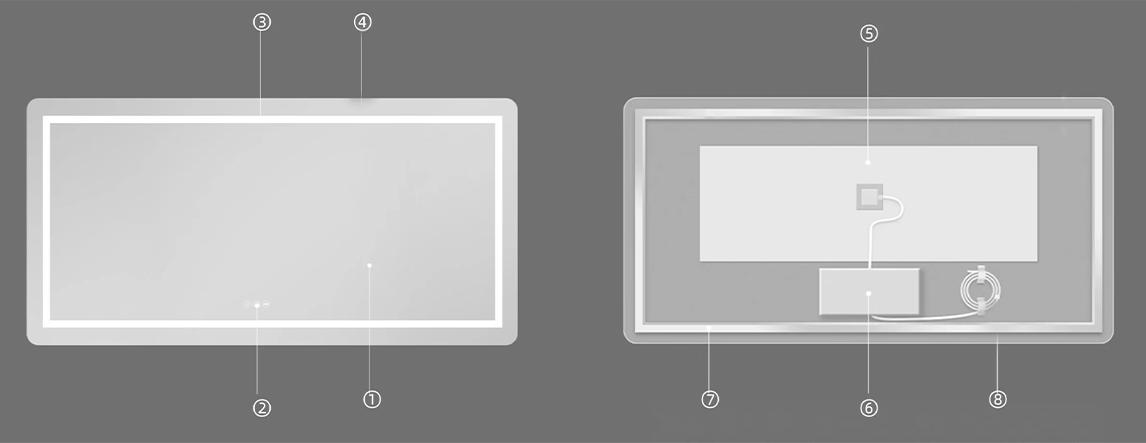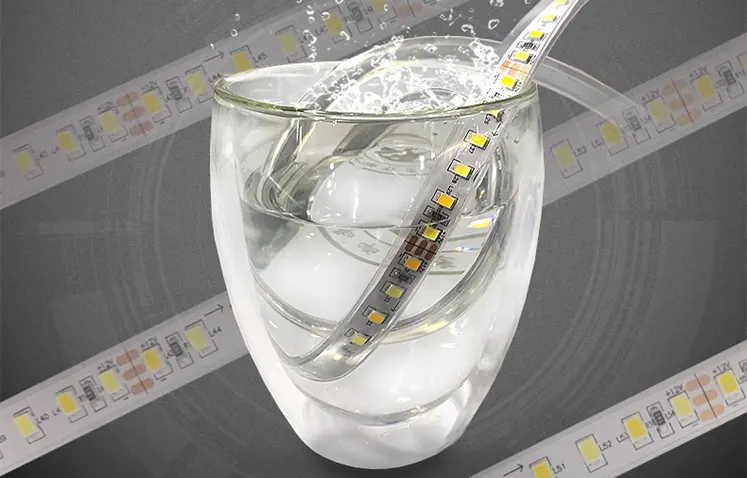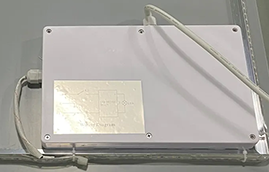Table of Contents
LED lighting for mirrors has become a crucial feature in modern homes, particularly in bathrooms where both function and style are essential. While these LED mirrors for bathrooms enhance the aesthetics and utility of the space, they can sometimes encounter issues. A common problem that users face is when their LED bathroom mirror suddenly stops working. This article delves into the possible reasons behind such malfunctions, offering guidance on troubleshooting and fixing these issues.

1. Common Reasons Your LED Bathroom Mirror May Stop Working
1.1. Power Supply Issues
- Faulty Power Connection: One of the primary reasons an LED bathroom mirror may fail is due to power supply problems. Ensure the mirror is properly connected to an outlet. You can test the outlet by plugging in another device to verify its functionality.
- Blown Fuse or Tripped Circuit Breaker: In the high-humidity environment of a bathroom, electrical components can be more susceptible to issues. Check if the circuit breaker for your bathroom is on, and replace any blown fuses as needed to restore power to your LED lighting for mirrors.
|
Issue |
Potential Cause |
Solution |
|
Mirror not turning on |
Faulty power connection |
Check power outlet and connections |
|
No power in the outlet |
Blown fuse or tripped circuit breaker |
Replace fuse or reset circuit breaker |
|
Dim or flickering lights |
Low voltage or power fluctuations |
Check electrical stability; consult an electrician |
1.2. LED Strip Failure
-
Worn-Out LED Strips: The LED strips in your mirror have a limited lifespan. Over time, they may degrade and eventually fail. If your LED mirror for bathroom is flickering or not lighting up, worn-out strips could be the cause.
Steps to Diagnose and Replace LED Strips:
- Turn Off the Power:Ensure the mirror is unplugged or the circuit breaker is switched off to avoid any electrical hazards.
- Remove the Mirror:Carefully take down the mirror from its mounting to access the back panel. You might need a screwdriver to open the panel where the LED strips are housed.
- Inspect the LED Strips:Check for any signs of wear, such as discoloration or broken connections. If the LEDs are visibly damaged or discolored, it’s likely time for a replacement.
- Test the Connections:Use a multimeter to check if power is reaching the LED strips. If there is no power, the issue may lie with the power supply or wiring.
- Replace the LED Strips:If the strips are worn out, carefully remove them and replace them with new ones of the same type. Be sure to reconnect the wires securely.
- Reassemble the Mirror:Once the new strips are in place, close the back panel, remount the mirror, and restore power.
These steps will help you self-diagnose and handle minor issues related to worn-out LED strips, ensuring your LED bathroom mirror remains in good working order.
-
Moisture Damage: Given the high humidity levels in bathrooms, moisture can seep into the LED lighting for mirrors, causing damage to the LED strips. This can lead to malfunctions or a complete failure of the lighting.
- Choose a moisture-resistant mirror:To prevent moisture damage to LED bathroom mirrors, consider using mirrors that are specifically designed with moisture resistance in mind. Look for LED mirrors that have sealed or waterproof casings to protect the internal components from humidity.
- Inspect and maintain regularly:Additionally, regular maintenance is crucial; inspect the mirror and its LED strips periodically to ensure there is no moisture ingress. If any signs of moisture are detected, such as fogging or water droplets inside the mirror, address the issue immediately by drying the affected area and improving bathroom ventilation.
- Keep the mirror dry:Regularly wiping down the mirror and avoiding direct exposure to water can also help extend the lifespan of your LED lighting for mirrors.

1.3. Faulty Dimmer Switch and Troubleshooting Steps
If your LED bathroom mirror features a dimmer switch, inconsistent lighting may point to an issue with this component. A malfunctioning dimmer can cause LEDs to flicker, dim unevenly, or stop working altogether, significantly affecting the mirror’s performance. Before assuming the dimmer is faulty, try adjusting the brightness levels to see if the lighting stabilizes. If the problem persists, here are a few steps you can take to diagnose and potentially resolve the issue:
- Inspect the Dimmer Switch: Carefully remove the dimmer switch cover and check for any loose or disconnected wires. Ensure all connections are secure. If the wiring appears intact, but the issue persists, the dimmer switch itself may need replacement.
- Test with a Regular Switch: To confirm that the dimmer is the culprit, temporarily replace it with a standard switch. If the lighting stabilizes, this indicates that the dimmer switch is faulty and should be replaced with a compatible model.
- Check for Power Fluctuations: Sometimes, inconsistent lighting can be due to power fluctuations rather than the dimmer switch itself. Use a multimeter to check the voltage at the dimmer switch. If the voltage is unstable, it may be worth consulting an electrician to inspect your home’s wiring.
By following these steps, you can identify whether the dimmer switch is causing the problem and take appropriate action to restore optimal performance to your LED mirror. If you’re unsure about handling electrical components, it’s advisable to seek professional help to avoid further damage or potential safety risks.

1.4. Loose or Damaged Wiring
- Loose Connections:
Over time, vibrations or improper installation can loosen the wiring within the mirror. This can cause intermittent power issues, leading to LED lighting for mirrors malfunctioning.
- Damaged Wiring:
If the wiring has become damaged due to moisture exposure or physical trauma, its electrical connection could become severed resulting in an unusable mirror.
1.5. Internal Component Failure
- Driver Failure:
The LED driver regulates the power to the lights. If this component fails, the LEDs may not receive the required voltage and could stop working. Replacing the driver is often necessary to restore the functionality of your LED mirror for bathroom.
Troubleshooting Steps (Check the LED Driver):
- – Symptom: Lights flicker or do not turn on.
- – Action: Use a multimeter to check the voltage output of the LED driver. If the output is inconsistent with the specified voltage, the driver likely needs replacement.
- Control Board Issues:
Advanced features like touch controls or Bluetooth connectivity in LED lighting for mirrors rely on the control board. If this component fails, these features and the lighting might stop working as intended.
Troubleshooting Steps (Inspect the Control Board Connections):
- – Symptom: Touch controls or Bluetooth features are unresponsive.
- – Action: Ensure that all connections on the control board are secure. Loose connections can lead to intermittent issues. If the problem persists, the control board may need to be replaced.

1.6. Environmental Impacts on LED Mirrors
- High Humidity: High humidity can cause significant issues for LED bathroom mirrors, primarily through the process of condensation. When moisture accumulates on the mirror’s surface and within its casing, it can infiltrate the electrical components, such as the LED strips and drivers. This moisture can lead to short circuits, corrosion, and other forms of damage, resulting in flickering lights, reduced brightness, or complete failure of the LED system. To mitigate these risks, it is crucial to ensure proper ventilation in the bathroom. Installing exhaust fans, using dehumidifiers, or opening windows can help maintain a lower humidity level, reducing the likelihood of condensation forming on the mirror.
- Temperature Fluctuations: Bathrooms often experience sudden changes in temperature, especially when hot showers or baths are involved. These fluctuations can cause thermal expansion and contraction of the mirror’s components, particularly in the LED lights and their housing. Over time, this repetitive stress can lead to cracks in the LED casing, weakened solder joints, and disconnections within the circuit. Additionally, temperature variations can cause condensation to form inside the mirror, further exacerbating moisture-related damage. To protect your LED mirror, consider installing it in a location less prone to direct exposure to steam and temperature extremes. Using mirrors with built-in temperature regulation features or those designed to withstand bathroom environments can also prolong their lifespan.
2. How to Troubleshoot and Fix Your LED Bathroom Mirror
When your LED bathroom mirror stops working, systematic troubleshooting helps identify the root cause quickly. Research shows that up to 40% of LED lighting failures are linked to power supply issues, while 30% stem from LED strip degradation due to heat or moisture (U.S. Department of Energy, 2020, DOE Report). A case study by Lighting Research Center found that bathroom humidity can reduce LED lifespan by nearly 20% in poorly ventilated spaces (LRC, RPI). By following structured steps—checking the power, wiring, and components—you can often restore function without replacing the entire mirror.
2.1. Check the Power Supply
First, verify that the power supply to your LED mirror for bathroom is functioning correctly. Check outlets, plugs, and circuit breakers. If there are any discrepancies, address them promptly to restore power to your LED lighting for mirrors.
Test the Power Source
Check the Outlet: Plug a different, known-working device (like a hair dryer) into the same electrical outlet to see if it powers on.
Reset the Circuit Breaker: If the outlet isn’t working, go to your home’s electrical panel and reset the circuit breaker for that circuit.
2.2. Inspect the LED Strips
If you notice flickering or dimming in the LEDs, inspect the strips for any visible signs of wear or damage. Replacing the strips may be necessary if they are no longer functioning correctly.
2.3. Examine the Dimmer Switch
For mirrors with dimmer switches, test the switch by adjusting the brightness levels. If the lights do not respond as expected, the dimmer switch may need to be replaced to maintain the quality of your LED lighting for mirrors.
Clean Sensors
If your mirror has a touch sensor or switch, clean it to ensure it’s not obstructed or dirty.
2.4. Check for Loose Wiring
Unhook the mirror from its mounting and carefully inspect the wiring. Ensure all connections are secure and free from damage to keep your LED lighting for mirrors operational.
Use a Multimeter (if comfortable): A multimeter can confirm if there’s voltage or a short circuit.
2.5. Replace Faulty Components
If you identify a defective driver or control board, replacing these components is essential. Consult with the manufacturer or a professional electrician to ensure the safe and correct installation of new parts, ensuring the continued functionality of your LED mirror for bathroom.
2.6. Address Environmental Concerns
Improving bathroom ventilation and reducing humidity levels can help prevent future issues with your LED lighting for mirrors. Regularly wipe down the mirror to keep it dry and free from moisture-related damage.
LED Mirror Maintenance Checklist
|
Maintenance Task |
Frequency |
Purpose |
|
Clean the mirror surface |
Weekly |
Prevent dust and moisture buildup |
|
Inspect power connections |
Monthly |
Ensure stable power supply |
|
Check LED strip functionality |
Every 6 months |
Identify early signs of wear or failure |
|
Test dimmer switch |
Quarterly |
Ensure smooth and consistent lighting |
|
Inspect for moisture ingress |
Biannually |
Prevent potential water damage to components |
3. When to Seek Professional Help
If your LED bathroom mirror still isn’t working after troubleshooting, it may be time to seek professional help. For example, if you notice flickering lights despite having checked and secured all connections, or if the mirror does not light up at all even after replacing the fuse or checking the power supply, these could indicate deeper electrical issues. Additionally, if there is visible water damage or signs of corrosion on the wiring or LED components, it’s essential to seek expert assistance. Contacting an electrician or the manufacturer can help diagnose and resolve these issues, ensuring that your LED lighting for mirrors is restored to its full functionality.
At Aosmay, we are committed to providing high-quality LED mirrors for bathrooms that are designed to last. Our mirrors are crafted with precision and built to withstand the rigors of daily use in bathroom environments. If you are experiencing issues with one of our products, please click here to contact our support team for assistance.
4. Conclusion
LED lighting for mirrors is an integral part of modern bathrooms, providing both functional and aesthetic benefits. However, like any electronic device, LED mirrors for bathrooms can occasionally experience issues. Understanding the potential causes and troubleshooting steps can help you address these problems efficiently. Regular maintenance and prompt action will ensure your LED bathroom mirror continues to perform optimally.
For more information on LED lighting for mirrors and to explore our range of products, visit our Aosmay website today.
If you are interested in LED Lighting For Mirrors, you can read previous articles to learn about industry information.
Are LED Light Mirrors Expensive to Run?
How Long Do LED Lights Last Before They Burn Out?
Do Backlit Mirrors Provide Enough Light?